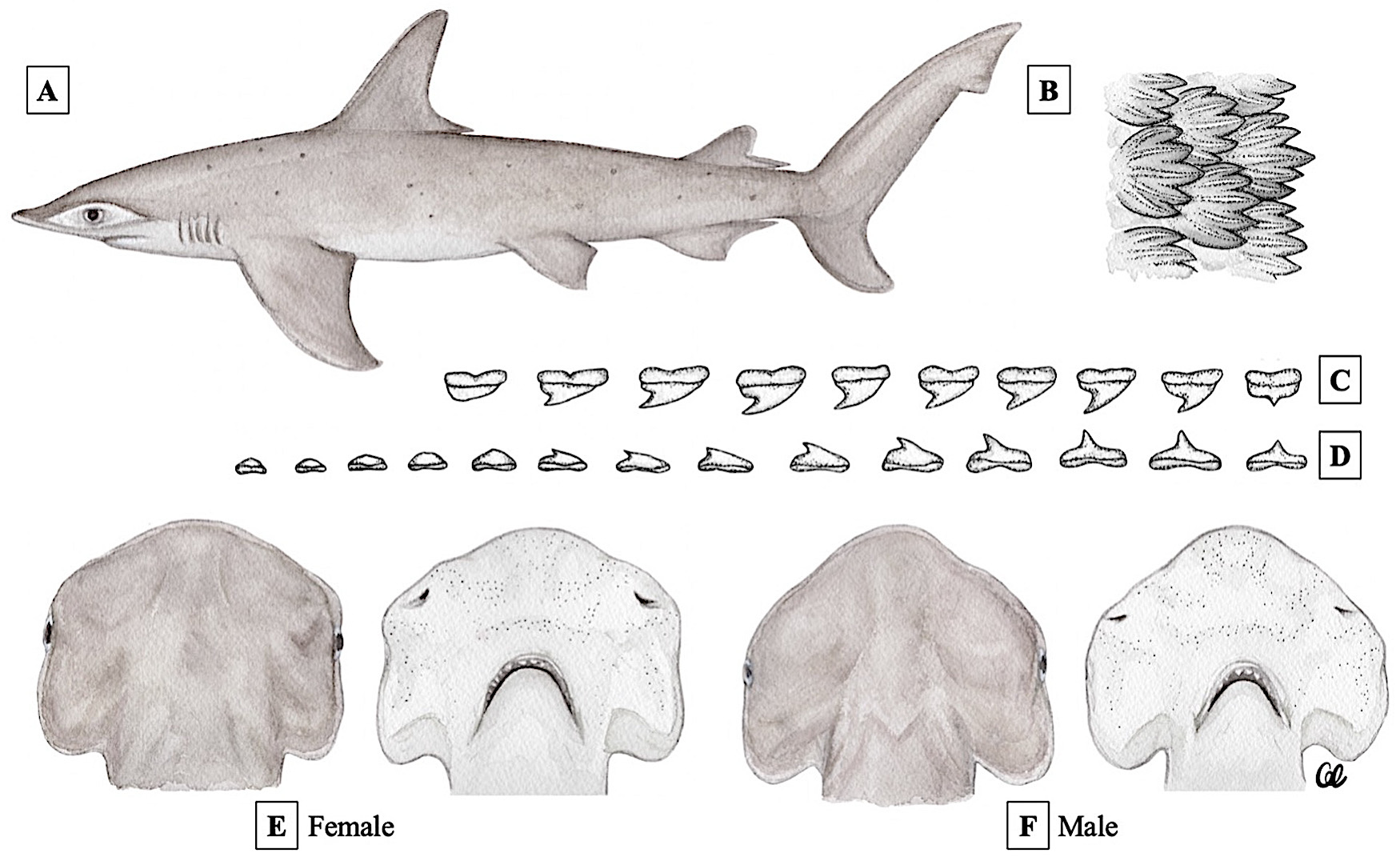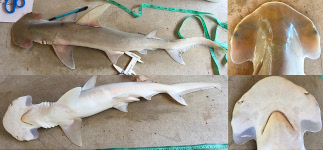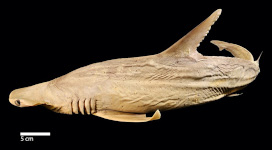Sphyrna alleni
Gonzalez, Postaire, Driggers, Caballero & Chapman, 2024
Classification: Elasmobranchii Carcharhiniformes Sphyrnidae
Reference of the original description
Sphyrna alleni sp. nov., a new hammerhead shark (Carcharhiniformes, Sphyrnidae) from the Caribbean and the Southwest Atlantic. Zootaxa, 5512(4), 491–511
Sphyrna alleni sp. nov., a new hammerhead shark (Carcharhiniformes, Sphyrnidae) from the Caribbean and the Southwest Atlantic. Zootaxa, 5512(4), 491–511
Types
Sphyrna alleni
Holotype: UF: 245705; Paratype: UF: 245723; UF: 245724; UF: 245725; UF: 245726; UF: 245727;
Sphyrna alleni
Holotype: UF: 245705; Paratype: UF: 245723; UF: 245724; UF: 245725; UF: 245726; UF: 245727;
Description :
Citation: Sphyrna alleni Gonzalez, Postaire, Driggers, Caballero & Chapman, 2024: In: Database of modern sharks, rays and chimaeras, www.shark-references.com, World Wide Web electronic publication, Version 01/2026
Please send your images of "Sphyrna alleni" to info@shark-references.com

Sphyrna alleni Gonzalez, Postaire, Driggers, Caballero & Chapman, 2024, A) Horizontal view of the shark; B) dermal denticles; C) upper and D) lower teeth; Dorsal and ventral representation of the head shape of E) Female and F) Male © Gina Clementi

Sphyrna alleni Gonzalez, Postaire, Driggers, Caballero & Chapman, 2024, A) Horizontal view of the shark; B) dermal denticles; C) upper and D) lower teeth; Dorsal and ventral representation of the head shape of E) Female and F) Male © Gina Clementi
Common names
 Tiburón Cabeza de Pala,
Tiburón Cabeza de Pala,  Requin-marteau pelle,
Requin-marteau pelle,  Shovelbill Shark
Shovelbill Shark
 Tiburón Cabeza de Pala,
Tiburón Cabeza de Pala,  Requin-marteau pelle,
Requin-marteau pelle,  Shovelbill Shark
Shovelbill Shark
Short Description
Original diagnosis of Gonzalez, Postaire, Driggers, Caballero & Chapman, 2024 [33490]: Small hammerhead shark (<150 cm at maturity) with a flat, shovel shaped head that lacks indentations on its anterior edge. Cephalofoil anterior margin is pointed (like a tringle) in both sexes and the posterior margins are lobule shaped. The anterior margin of males exhibits a pronounced bulge. Enlarged, molariform posterior teeth, first dorsal rear tip in front of pelvic origins, and shallowly concave posterior anal margin. It is distinct from S. tiburo because in this species the anterior margin of the head is more rounded and the lobules on the posterior margin are not present. Precaudal vertebral counts for S. alleni sp. nov., are between 80-83 (~10 more vertebrae than S. tiburo).
Original diagnosis of Gonzalez, Postaire, Driggers, Caballero & Chapman, 2024 [33490]: Small hammerhead shark (<150 cm at maturity) with a flat, shovel shaped head that lacks indentations on its anterior edge. Cephalofoil anterior margin is pointed (like a tringle) in both sexes and the posterior margins are lobule shaped. The anterior margin of males exhibits a pronounced bulge. Enlarged, molariform posterior teeth, first dorsal rear tip in front of pelvic origins, and shallowly concave posterior anal margin. It is distinct from S. tiburo because in this species the anterior margin of the head is more rounded and the lobules on the posterior margin are not present. Precaudal vertebral counts for S. alleni sp. nov., are between 80-83 (~10 more vertebrae than S. tiburo).
Dentition
25 teeth in average in the upper and lower rows of functional teeth; anterior teeth not serrated with short, smooth-edged cusps; posterior molar teeth with a broader basis, flattened, cusp-less, keeled, expanded, and rounded; lower teeth shorter than uppers. Labial furrow around corner of mouth on the lower jaw, but none on the upper jaw; Teeth counts of the functional rows for the upper and lower jaw were 25 in average for each row. When compared to S. tiburo no significant differences in shape or structure of the jaws were found. The S. alleni sp. nov., sharks have anterior teeth that are pointier, narrower, and more sharpened than S. tiburo, that have wider teeth. Also, S. alleni sp. nov., the anterior and posterior teeth seem to be bigger than S. tiburo. Lower jaw: S. alleni sp. nov., have fewer posterior teeth without cusps with a flatter crown foot, fewer rows of teeth exposed (3-2 rows), and are more spaced than S. tiburo. Contrary, the arrangement of posterior teeth in S. tiburo is a clumped pattern and more rows of teeth are exposed (5-3 rows). Upper jaw: S. alleni sp. nov., have only one column of posterior teeth without cusps and flattened crown foots. The second column of teeth have a small cusp developed, that starts to get more prominent until the anterior teeth with well-defined cusp ends. In comparison, the upper jaws of S. tiburo have 3 columns of posterior teeth that are cusp-less and flattened. Only in the 4th column of posterior teeth the cusps start to develop, but they are not as pointed and sharp as the new species. [33490]
25 teeth in average in the upper and lower rows of functional teeth; anterior teeth not serrated with short, smooth-edged cusps; posterior molar teeth with a broader basis, flattened, cusp-less, keeled, expanded, and rounded; lower teeth shorter than uppers. Labial furrow around corner of mouth on the lower jaw, but none on the upper jaw; Teeth counts of the functional rows for the upper and lower jaw were 25 in average for each row. When compared to S. tiburo no significant differences in shape or structure of the jaws were found. The S. alleni sp. nov., sharks have anterior teeth that are pointier, narrower, and more sharpened than S. tiburo, that have wider teeth. Also, S. alleni sp. nov., the anterior and posterior teeth seem to be bigger than S. tiburo. Lower jaw: S. alleni sp. nov., have fewer posterior teeth without cusps with a flatter crown foot, fewer rows of teeth exposed (3-2 rows), and are more spaced than S. tiburo. Contrary, the arrangement of posterior teeth in S. tiburo is a clumped pattern and more rows of teeth are exposed (5-3 rows). Upper jaw: S. alleni sp. nov., have only one column of posterior teeth without cusps and flattened crown foots. The second column of teeth have a small cusp developed, that starts to get more prominent until the anterior teeth with well-defined cusp ends. In comparison, the upper jaws of S. tiburo have 3 columns of posterior teeth that are cusp-less and flattened. Only in the 4th column of posterior teeth the cusps start to develop, but they are not as pointed and sharp as the new species. [33490]
Remarks
shark-references Species-ID=17436;
shark-references Species-ID=17436;


















